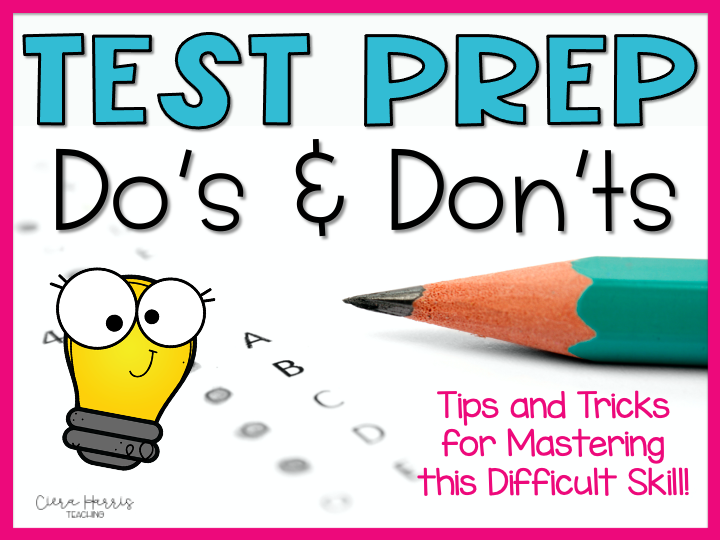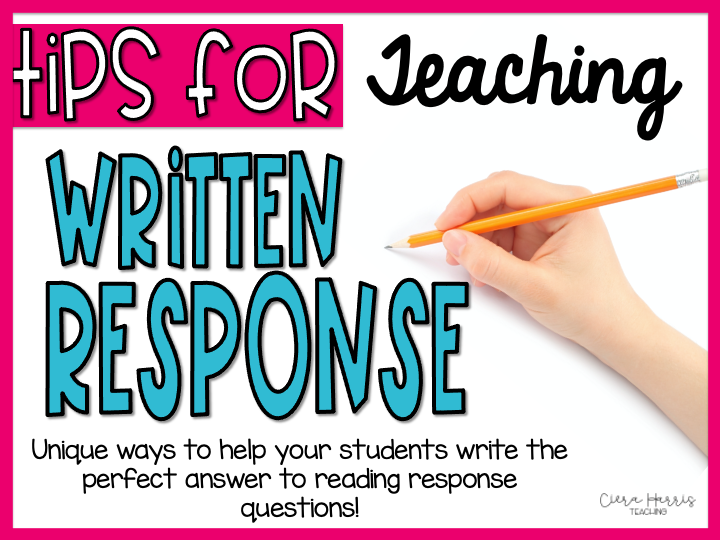It’s February & March, that dreaded time of year when upper elementary teachers start to think about the dreaded standardized tests. It’s time to cram in as many test-taking strategies and review standards as possible. Or is it…? To help our students achieve, what SHOULD teachers be doing to support them? What strategies work and which ones don’t? Could there be things teachers are doing that are hurting student outcomes? Check out this list of test prep do’s and don’ts to see just what you should (and shouldn’t) be doing in your classroom!

Want to watch the video instead? Check it out below! Make sure to subscribe to get updates on all new content!
Test Prep Do’s
1.) Teach students HOW to take a test!
I think this is one of the most overlooked strategies that teachers could be using. It’s always assumed that students know HOW to take a test. But do we ever actually teach them this skill? And if so, what does this look like?
Teaching how to take a test is not only important for standardized tests but also for the ‘everyday’ assessments that teachers may be given. Students need to know how to analyze test questions to understand their meaning. They need to know that they can annotate those questions to make notes for themselves. Students need to know how to evaluate multiple-choice answers. Which one is the ‘definitely not’ choice? Which one is the ‘trying to trick me’ choice? Students also need to know strategies like how to find words or phrases in a question and then locate those words in the text to quickly find evidence to support their answers.
The question is – are teachers doing this? This is definitely a test prep DO and one that should start way at the beginning of the school year to help create test-taking habits in our students.
2.) Give students specific strategies to use for test prep and explicitly teach them.
This one goes a little bit further than the tip above. These strategies are basically important reminders for students to use when taking any type of test. Again, like the tip above, this  should be implemented EARLY on in the school year and not crammed into students two weeks before taking a standardized test. When starting early, modeling these strategies, and explicitly teaching them one at a time, we are allowing our students to create positive test-taking habits that they will carry on with them for years to come.
should be implemented EARLY on in the school year and not crammed into students two weeks before taking a standardized test. When starting early, modeling these strategies, and explicitly teaching them one at a time, we are allowing our students to create positive test-taking habits that they will carry on with them for years to come.
Some of the test prep strategies I typically use are:
- Read all directions carefully
- Read the questions before reading the text
- Identify keywords in the question
- Paraphrase the question in your own words
- Read all choices before selecting
- Cross out incorrect answers
- Go back to the text to find evidence
- Select the best choice
If you want to snag some free test prep resources to help, check out my article on Test Prep Tips That Work! You can snag my free test prep foldable along with some test prep posters too!
3.) Keep your normal structure and schedule.
One thing that always messes students up is when our schedule is thrown off. It’s bound to happen one time or another for special occasions but when it comes to instruction, keeping the same routine and schedule is a must. This is especially true during the test-taking season.
We should not be changing this up to squeeze in test prep activities, review activities, testing rallies, etc. All this is going to do is create anxious students because we are bringing more attention to the test than we should be. Keep things as normal as possible.
4.) Use data!
Reviewing for standardized tests is inevitable, however, there are certain precautions teachers need to take to ensure success for students. One of them is not to overteach. I get the sensation of dread thinking there isn’t enough time to get everything in and teachers try and try to review as much as possible. But that’s not necessary. Teachers are sitting on months worth of data that they can use to make data-driven decisions on what exactly needs to be reviewed for the test.
A few ways you can use data: Take a look at past test averages and determine which ones were the lowest. This allows you to easily identify standards you’ve taught that need to be reviewed whole group. You can also identify the ‘star standards’ (most important ones) and create focus groups of students to review standards that only a few students need help with.
5.) Focus on their mindset
 This is probably the most important ‘do’ of all. But again, like many of the other things mentioned above, it needs to start early in the school year. Creating a classroom culture centered around a growth mindset, determination, goal setting, and hard work is essential to students’ success on standardized tests. Students need to feel loved, supported, and confident. They need to know that it’s okay to make mistakes and that’s where the magic of learning takes place!
This is probably the most important ‘do’ of all. But again, like many of the other things mentioned above, it needs to start early in the school year. Creating a classroom culture centered around a growth mindset, determination, goal setting, and hard work is essential to students’ success on standardized tests. Students need to feel loved, supported, and confident. They need to know that it’s okay to make mistakes and that’s where the magic of learning takes place!
They need to feel brave enough to take chances knowing that you are going to be there to help them if they fail. Without this culture and supportive environment, students may not believe in themselves enough to truly put the hard work behind their test-taking abilities.
Check out my Growth Mindset Read Aloud Activities if you need somewhere to start!
Test Prep Don’ts
1.) Don’t make test prep a big deal!
Have you ever been hyped up about something? Maybe it was getting your driver’s license or riding a roller coaster for the first time. You had people all around you talking about this big event, encouraging you, pushing you, and cheering you on. How did that make you feel? It may have brought out some positive emotions, but I bet it also brought out a lot of negative ones too. Did it make you feel anxious or nervous? Maybe it made you question things when you were making decisions.
When we put up so much hype around standardized tests, we are creating so much pressure for our students that the pressure becomes a negative consequence. And the problem is – we may not even see it! Students may be jumping and cheering right along with you one day and then on the day of the test, their brains are filled with worries, regrets, anxieties, and much more. If we treat this test like it’s a normal day, our everyday confidence can be used to support students. And that’s enough. 🙂
2.) Don’t teach to the test
I don’t even know how this is possible anymore with standardized tests being on lockdown. But there are teachers who believe in taking this to the extreme. Most states put out a standards blueprint that allows teachers to see the variation of standards being used in the test as well as how much those standards take up within the test. (this standard will be used 30% of the test, etc). It’s okay to use this blueprint to help guide some review but don’t take it too far.
You don’t need to get out last year’s standardized test questions to go over. Also, you don’t need to create a detailed checklist from the blueprint to ensure you’ve covered everything they say is going to be on the test. You should be relying on ONE thing – your instruction from the last year you’ve been with those students. If you’re not confident that THAT instruction can do the trick and help students pass – then there’s a problem. 😉
3.) Don’t let test prep take over your instructional time
Just like I mentioned above, test prep season should be kept as normal as possible. If you need to review, that’s fine! But your review lessons should look and feel like normal, everyday lessons. We shouldn’t be stopping our tier one, grade-level instruction in order to ‘fit in’ test prep. This actually is doing the opposite of what we want it to do. Tier one instruction is what’s going to help our students succeed – so why would we stop teaching?
If we need to review, we need to find time outside of our normal tier-one instruction. Whether that be in an extra time of day or during small groups. Our normal routine and grade-level instruction shouldn’t be hindered because it’s test-taking season.
4.) Don’t make test prep boring
Engagement should always be a core component of your instruction and test prep season is no different! This time of year students are inching closer and closer to summer. If you  take standardized tests before spring break, then your students are antsy for the break. If you take standardized tests after spring break, then your students are coming back from not being in school – and we know what that’s like!
take standardized tests before spring break, then your students are antsy for the break. If you take standardized tests after spring break, then your students are coming back from not being in school – and we know what that’s like!
Ensuring that we are engaging all of our students in each lesson ensures that they are on task, invested, and showing responsibility for their learning. This gets students up and around the room, talking with peers, using critical thinking, and more! If you haven’t checked out my Engagement Strategies this would be a great time to do so! There are over 60 engagement strategies that teachers can use with any lesson, subject, or grade level and they all ensure 100% participation!
5.) Don’t try and review everything
It’s not going to happen. No way, no how. This is why data is so important to help drive your instruction and your review. Use your state’s standardized testing blueprints as a guide and your data to support and make a detailed plan.
Which standards need to be reviewed whole group? Which standards need to be reviewed in small groups and with whom? Having a plan helps you feel in control and confident as the test approaches.
I hope you found some new test prep tips today! If you want to save this post for later, just pin the image below.






